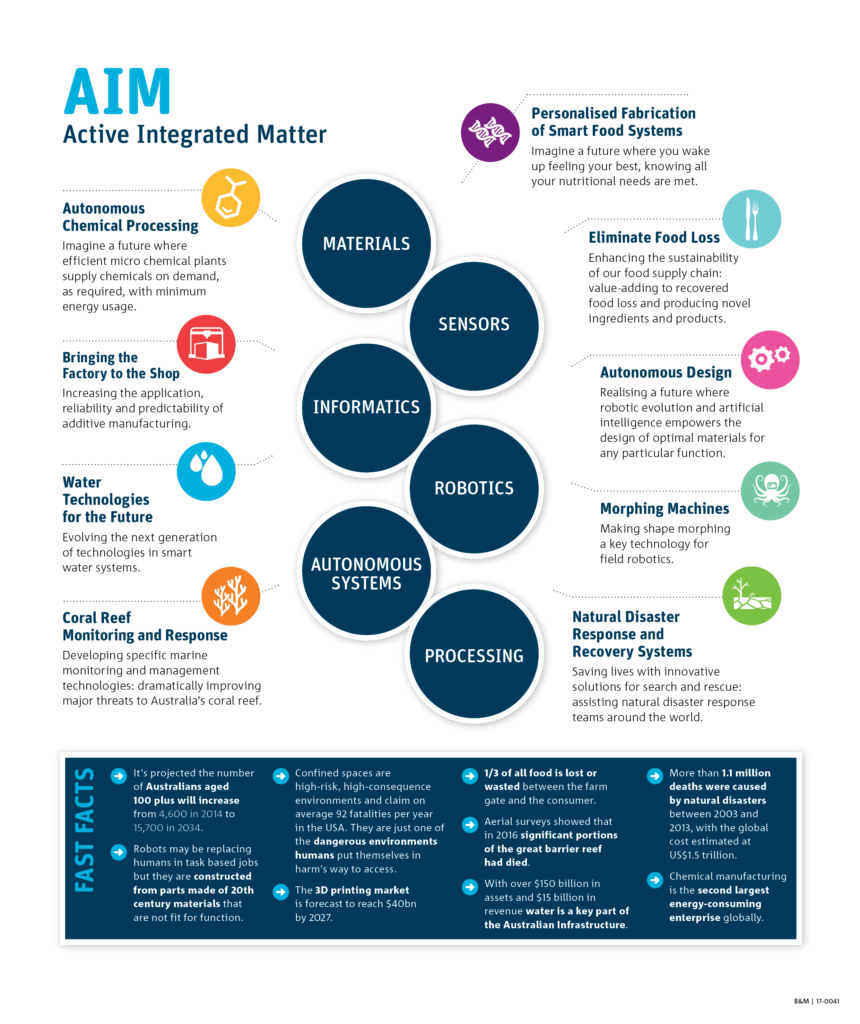Our AIM scientists are working on science that will change the way we live. Flickr/CC/John Biehler
Imagine a world where disaster rescue robots can readily change their body size and shape to adapt to different terrains and environments. A world where some of the in-demand food products you consume have been developed from produce previously lost or wasted in the supply chain. Or a world where bespoke products and spare parts are effortlessly created in mini, mobile manufacturing plants.
Our Active Integrated Matter (AIM) team is working on a few projects, just like these! AIM’s physicists, roboticists and chemists are developing the type of next-gen science that will change the way we live.
So let’s take a closer look at the next five big things in science.
1. The rise of the machines – Autonomous design
We’ve all heard how robots are going to change our lives for the better by doing the repetitive tasks that cost time and money. They’re even set to play a key role in the future of economic health in industrialised nations. Unfortunately their uptake has been slow because of their complex design and lack of configuration options.
Until the AIM team started to think about it.
Taking inspiration from genetics and Darwin’s “survival of the fittest”, evolutionary computing may provide the unconventional solutions needed to solve the problems that human optimisers have found difficult, or impossible, to solve. The next gen robots and their components will be evolutionary – formed through, and tailored to, their environment.
Over a number of generations, promising traits will be “bred” into robotics. We can use machine learning to discover unconventional materials, sensors, and actuators. Team this with advanced processing methods, and it will allow the creation of whole robotic systems without human intervention.
2. & 3. Eliminating food loss and customised food according to individual DNA
Approximately 800 million people around the world are currently undernourished, and by 2050 it’s predicted 9 billion people will need to be fed in an environmentally and nutritionally sustainable way. With one third of the food we produce wasted, we are contributing to both food insecurity and negative environmental impacts.
We can develop safe and healthy products (whilst reducing food loss) through intelligent decision making tools, novel sensors and new transformative food processing technologies. That means turning those discarded bits of fruit and veg between farm and supermarket, like left-overs from juicing, canning and processing, into yummy new products.
Imagine individualised foods and nutraceuticals that fit the exact requirements of an individual’s body at any given time. Food that is tailored to an individual’s genetic blueprint, phenotype and physiological condition. Food, designed specifically for you.

AIM: Changing the world as we know it
4. Bringing the factory to the shop
3D printing, or additive manufacturing (AM), is a technology that’s set to change the manufacturing game. 3D printers are already available to small shops and businesses, meaning factories and distribution warehouses may soon be a thing of the past.
To help make this a reality, the next generation of 3D printers will possess a host of features to make designs more reliable, predictable and more complex. Say hello to easier adoption from innovation to industry.
Products with intricate internal details can be printed in a simple 3D printer. This in itself will be revolutionary in the manufacturing industry.
5. Natural disaster response and recovery
As the frequency and severity of natural disasters increase, billions of people around the world are impacted. More than 1.1 million deaths were caused by natural disasters between 2003 and 2013, with the global cost estimated at US$1.5 trillion. Deploying robots of novel designs and different modalities in disaster situations allows easy access to environments unsafe for humans. A ‘collaborative ‘team’ of robots will be able to achieve goals that humans could not have otherwise done.
Material meets digital
AIM is blending robotics, sensing, processing, materials and data science to develop exciting new scientific applications and create innovative new industries for Australia and around the world.



28th July 2020 at 9:31 am
Imagination fuels innovation. If we can imagine it, we can create it. Stargate, the rise of the machines, cure for cancer.. et al. Science Fiction is science reality awaiting discovery. The best question worth thinking about – is what is consciousness? At what point our our machines with AI (AIM) self-aware?
22nd February 2017 at 4:48 pm
Sounds like a bunch of buzzwords with barely any information regarding the practical application of these ‘ideas’. A list of dreams and nothing more.